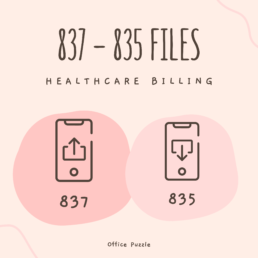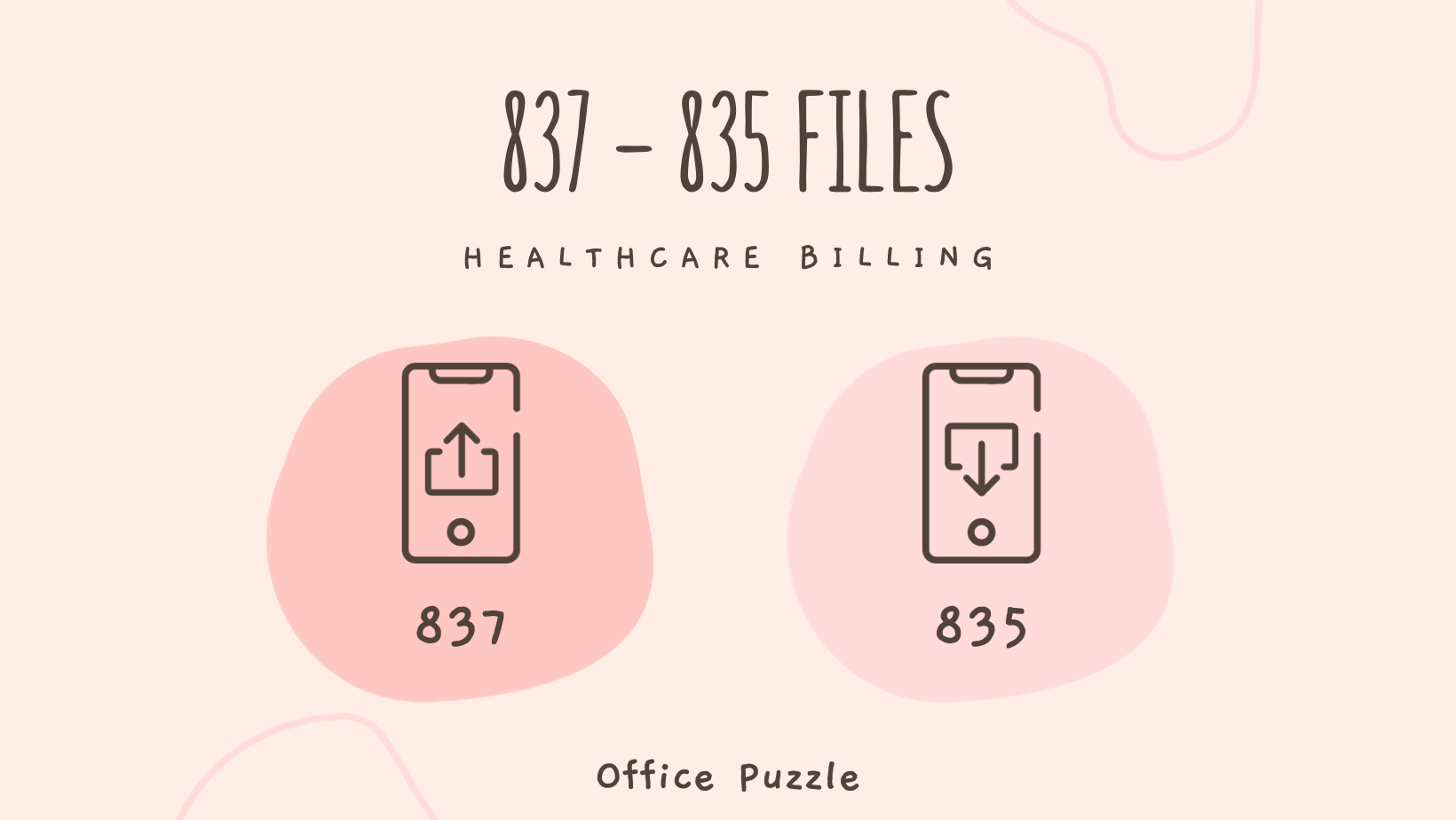Understanding 835 and 837 files in Billing
The healthcare industry relies heavily on accurate and efficient billing processes to ensure the smooth flow of financial transactions between providers and payers. Two essential components of this process are the 835 and 837 files. These files play a crucial role in healthcare claims and remittance. In this article, we will explore what 835 and 837 files are, how they work, and their significance in the healthcare billing process.
What is an 837 File?
An 837 file is an electronic claim submission document used by healthcare providers to submit claims for reimbursement to payers. It contains comprehensive information about the services provided to patients, along with associated diagnosis and procedure codes. The 837 file is the format in which providers send billing information to payers electronically.
Key components of an 837 file include:
- Patient Information: Demographic details of the patient, such as name, date of birth, and insurance information.
- Provider Information: Information about the healthcare provider, including their NPI and contact details.
- Service Details: Descriptions of the services rendered, including CPT (Current Procedural Terminology) codes and ICD-10 (International Classification of Diseases, 10th Edition) diagnosis codes.
- Payer Information: Details about the insurance payer responsible for processing the claim.
- Claim Totals: Summaries of the charges, payments, and adjustments related to the claim.
Once the healthcare provider submits the 837 file to the payer, the payer processes the claim, which may result in the creation of an 835 file that provides information on the payment and any adjustments made.
What is an 835 File?
An 835 file, often referred to as an Electronic Remittance Advice (ERA), is an electronic document that provides detailed information about the payments and adjustments made by a healthcare payer (such as an insurance company or Medicare) to a healthcare provider. Essentially, it serves as a remittance advice that explains how a claim was processed and paid. Key information contained in an 835 file includes:
- Payment Details: This section includes the payment amount, payment method (e.g., electronic funds transfer), and payment date.
- Claim Information: It provides data related to the specific claim being paid, such as the claim number, patient information, and service details.
- Adjustments and Denials: Any adjustments or denials made to the claim are documented in this section. It explains why certain services were not covered or were partially paid.
- Provider Information: Details about the healthcare provider receiving the payment, including their name, National Provider Identifier (NPI), and address.
- Payer Information: Information about the healthcare payer responsible for processing the claim, including their name, payer ID, and contact information.
The 835 file is crucial for healthcare providers to reconcile their accounts receivable, understand the payment rationale, and address any discrepancies in payments.
The Relationship Between 835 and 837 Files
The 835 and 837 files are interconnected in the healthcare billing process. Here's how they work together:
- Claim Submission: Healthcare providers use the 837 file to submit claims electronically to payers.
- Claim Processing: Payers receive the 837 file, process the claim, and determine the appropriate reimbursement.
- 835 Generation: If the claim is approved, the payer generates an 835 file, which is sent back to the provider. This 835 file explains how the claim was processed and the payment details.
- Reconciliation: Healthcare providers use the information in the 835 file to reconcile their accounts and ensure they received the correct payment for services rendered.
- Resolution: If there are discrepancies or denials, providers can use the information in the 835 file to address these issues with the payer.
Office Puzzle ensures that agencies comply with HIPAA requirements while optimizing their billing management. One of the features of our platform specializes in the creation of 837 files and the ability to upload 835 files to the platform in the raw. The system identifies claims and batch issues that can hinder payment accuracy, as well as prevents specific denial issues.
Artificial Intelligence in Healthcare

The Power of AI
AI, or Artificial Intelligence, refers to the field of computer science that focuses on creating intelligent machines capable of performing tasks that typically require human intelligence. AI encompasses various techniques and algorithms, such as machine learning, natural language processing, and computer vision, to enable machines to perceive, learn, reason, and make decisions.
OpenAI is an organization that conducts extensive research and development in the field of AI. It aims to ensure that artificial general intelligence (AGI) benefits all of humanity and is committed to producing AI technologies that are safe, beneficial, and accessible. OpenAI has developed advanced language models, including GPT-3.5, to improve natural language understanding and generate human-like responses to a wide range of queries.
HIPAA Compliance
When it comes to sending Protected Health Information (PHI) to a computer running Artificial Intelligence (AI), there are potential challenges related to maintaining HIPAA compliance. HIPAA, the Health Insurance Portability and Accountability Act, sets standards for the privacy and security of individually identifiable health information. AI technology has the potential to revolutionize healthcare, but it must be used in a manner that aligns with HIPAA regulations to ensure patient privacy and data security.
One of the key considerations for using AI in healthcare is the implementation of de-identification methods. De-identification involves removing or altering certain identifiers from the health data to prevent the data from being linked to specific individuals. The HIPAA Privacy Rule provides guidelines for de-identification, and one recommended technique is known as the "Safe Harbor" method. This method involves removing identifiers such as names, addresses, dates, telephone numbers, Social Security numbers, and medical record numbers.
By applying the Safe Harbor method, organizations can eliminate specific identifiers that could be used to identify individuals. The rationale behind de-identification is that without these identifiers, the data no longer qualifies as personally identifiable health information (PHI) or personally identifiable information (PII). De-identified data can then be used for AI analysis without violating HIPAA regulations.
At Office Puzzle, we understand the importance of maintaining HIPAA compliance while utilizing AI in healthcare. We have taken steps to ensure that our AI models comply with HIPAA regulations, and we prioritize the protection of PHI throughout the entire process. By implementing appropriate de-identification techniques and robust security measures, we aim to harness the power of AI while safeguarding patient privacy and adhering to HIPAA guidelines.
You can read more about how to remain HIPAA compliant while using artificial intelligence (AI) in our blog post: https://www.officepuzzle.com/article/ai-models-in-healthcare-and-hipaa-compliance/.
We are proud to announce that Office Puzzle is now leveraging artificial intelligence in specific areas of our platform. By integrating AI technology, we strive to enhance the efficiency and effectiveness of healthcare processes while maintaining the utmost respect for patient privacy and data protection.

Autocomplete
This feature has been a core component of Office Puzzle since its inception and has undergone three updates to enhance its functionality. The most recent update introduces AI technology, elevating the clinical note process to a more comprehensive level. The note's content is derived from an actual questionnaire, captured through dropdowns and session-specific details, resulting in a summary note that users can review and approve before submitting.
Rest assured, the protection of personal health information (PHI) is of utmost importance. Prior to processing, all information is meticulously anonymized, ensuring that no PHI is transmitted to the AI. This robust anonymization process guarantees the privacy and confidentiality of user data while the note creation.
We make to ensure data safety are as follows:
- To ensure the protection of personal information, we employ a strict redaction process prior to submission. For instance, a text such as:"The services were provided at the agreed-upon time, Sarah and BCBA were present at the client's school." is transformed into: "The services were provided at the agreed-upon time, {{clientName}} and BCBA were present at the client's school.". By implementing this redaction technique, we eliminate the possibility of identifying individuals within the note. Once we receive the response, we securely restore the client's name within a HIPAA-compliant environment, ensuring privacy and compliance with regulations.
- Our approach to utilizing AI involves strict instructions to avoid content modification in any form. The AI's sole purpose is to rectify grammar errors and enhance readability. By adhering to this instruction, we ensure that the AI does not generate any independent ideas but remains confined to the user's input.

Data Analysis
Data Analysis is a valuable feature within Office Puzzle, designed to empower providers with a comprehensive overview of their data. By utilizing this feature, providers can swiftly identify trends and patterns within their data, enabling them to gain valuable insights. By inputting data collected over the past 6 months, the algorithm generates a concise analysis, giving a clear picture of the progress made thus far.
This feature significantly reduces the need for manual analysis, which often carries the risk of errors or prolonged processing times. By automating the data analysis process, providers can save valuable time and effort while obtaining accurate and reliable results. The Data Analysis feature serves as a powerful tool to streamline the analysis process, allowing providers to make data-driven decisions with confidence.
Providing a table full of data like this:
| Name | Baseline | January 2023 | February 2023 | March 2023 | April 2023 | May 2023 | June 2023 |
| Noncompliance | 90 | 89.05% | 85.53% | 82.57% | 79.22% | 77.79% | 75% |
| Mouthing | 32 | 31.5 | 28.5 | 28.4 | 27.25 | 26.5 | 25.75 |
| Physical Aggression | 42 | 40.75 | 39.75 | 36.8 | 37.25 | 35.5 | 34.5 |
| Elopement | 33 | 30.75 | 27.5 | 27.4 | 26.25 | 25.5 | 24.75 |
| Tantrums | 55 | 54.5 | 47.5 | 45.2 | 45 | 42.75 | 42.25 |
| Climbing | 34 | 33.75 | 29.25 | 29.2 | 30.5 | 29 | 27.5 |
| Hyperactivity | 62 | 61.25 | 52.75 | 51 | 51.5 | 51 | 50.25 |
The AI can generate a summary:
Based on the data provided for the last 6 months, here is a summary of the trends and progress:
- Noncompliance: There has been a steady decrease in noncompliance rates from January to June, indicating progress in this area. The baseline of 90% has decreased to 75%.
- Mouthing: The rates of mouthing behavior have shown a consistent decline over the last 6 months. This suggests progress in managing this behavior.
- Physical Aggression: Although there have been slight fluctuations, the overall trend for physical aggression is showing a slight decrease. This indicates some progress in addressing this behavior.
- Elopement: Elopement rates have been steadily decreasing, suggesting progress in managing this behavior over the last 6 months.
- Tantrums: There has been a general decline in tantrum behavior over the past 6 months. While there are minor fluctuations, the overall trend shows progress in reducing tantrums.
- Climbing: The climbing behavior has shown some variation, but there is no significant trend observed in the data for the last 6 months.
- Hyperactivity: Hyperactivity rates have remained relatively stable over the past 6 months, with a slight decrease observed in the most recent month. There is limited progress in managing hyperactivity.
Overall, there has been progress in managing noncompliance, mouthing, physical aggression, elopement, and tantrums. However, climbing behavior and hyperactivity have shown limited progress.

Service Plan
Coming soon!
--
Office Puzzle allows providers to shift focus back to patient care. All this while being compliant when performing their daily tasks. They use technology to solve most of the communication challenges, creating a more collaborative, transparent, and simpler exchange of information between providers and the agency staff.




